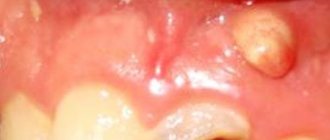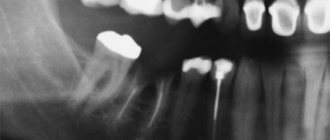Oral candidiasis
Clinical manifestations of oral candidiasis are quite diverse and can be expressed in the form of yeast stomatitis (thrush), glossitis, cheilitis, angulitis. There are acute (pseudomembranous and atrophic) and chronic (hyperplastic and atrophic) clinical forms of oral candidiasis.
The most common acute pseudomembranous candidiasis of the oral cavity occurs mainly in children of the first years of life, as well as in weakened and exhausted elderly people. It is characterized by the appearance of swelling, hyperemia and a milky-white cheesy coating on the mucous membrane of the back of the tongue, palate, cheeks and lips. Removal of plaque exposes a macerated or eroded bleeding mucosal surface. There is a burning sensation, pain and difficulty eating; children lose their appetite, become lethargic and capricious. The process can spread to the larynx, pharynx, and esophagus.
In the absence of treatment, thrush can develop into acute atrophic candidiasis of the oral cavity, accompanied by desquamation of the epithelium, severe hyperemia, swelling and dryness of thinned mucous membranes, and severe pain. The dorsum of the tongue acquires a fiery red color and shine, the filiform papillae atrophy, the red border of the lips and the corners of the mouth are affected. Fungal plaque is absent or accumulates in deep folds and is difficult to remove.
In the case of chronic hyperplastic candidiasis of the oral cavity, irregularly shaped, tightly fused gray-white plaques and papules with a rim of hyperemia are found on the mucous membrane of the cheeks and back of the tongue, which cannot be removed when scraped. Patients with this form of candidiasis are concerned about significant dryness in the mouth, roughness and soreness of the mucous membranes of the tongue and cheeks. The disease is usually detected in males over 30 years of age.
Chronic atrophic candidiasis of the oral cavity (denture stomatitis) is associated with prolonged pressure and trauma to the mucous membrane. It manifests itself as local damage to the area where the prosthesis is worn in the form of clearly defined bright erythema of the mucous membrane of the gums and palate, a slight plaque, and erosions of the corners of the mouth. The tongue is smooth, with atrophy of the papillae. Subjective sensations - pain, burning, dryness.
When candidiasis moves to the red border of the lips, candidal cheilitis develops, characterized by moderate swelling, maceration and superficial peeling of the lips, painful bleeding cracks and erosions, and the growth of thin grayish films and crusts. There is a burning sensation, dryness, and a feeling of tightening of the mucous membrane of the lips.
When a mycotic infection occurs in the corners of the mouth on both sides, maceration of the mucous membrane occurs, dry cracks with thickened roller-like edges and thin gray scales. When you open your mouth, the cracks bleed and cause pain. Oral candidiasis can occur in isolation or be combined with damage to other mucous membranes and skin; under unfavorable conditions and improper treatment, it can develop into generalized candidiasis with damage to internal organs and the development of candidal sepsis.
Candidiasis
Cervical cancer
Diabetes
HIV
Thrush
14185 July 27
IMPORTANT!
The information in this section cannot be used for self-diagnosis and self-treatment.
In case of pain or other exacerbation of the disease, diagnostic tests should be prescribed only by the attending physician. To make a diagnosis and properly prescribe treatment, you should contact your doctor. Candidiasis: causes, symptoms, diagnosis and treatment methods.
Candidiasis is an infectious disease caused by yeast-like fungi of the genus Candida. It is caused by the active proliferation of fungus on the mucous membranes of the oral cavity, genital and internal organs and on the skin.
All representatives of the genus Candida belong to opportunistic microorganisms, that is, they are constantly present in the normal microflora. But with a decrease in immunity, changes in hormonal levels and for a number of other reasons, these fungi can begin to actively colonize the mucous membranes and skin.
The most common members of the genus are Candida albicans and C. tropicalis. In 90-95% of cases of urogenital candidiasis, C. albicans is the dominant pathogen.
The first contact with fungi of the genus Candida occurs during the passage of the child through the birth canal. However, the medical literature describes cases of detection of these microorganisms in amniotic fluid, which indicates the possibility of a vertical (transplacental) transmission route. Transmission of the fungus of the genus Candida also occurs through breastfeeding, skin contact between the child and the mother, and through household and food routes.
These microorganisms produce endotoxins and enzymes that cause cell death and tissue necrosis, which enhances the adhesive (attachment to cells of the mucous membranes or skin) ability of the fungus and ensures penetration into tissue.
Overproduction of these and a number of other substances determines the pathogenicity of representatives of the Candida family.
Causes of candidiasis
- Exogenous (external) factors facilitating the penetration of fungi into the body:
- occupational hazards leading to frequent skin damage;
- prolonged exposure to a warm and humid environment;
- violation of the integrity of the mucous membranes.
- Factors leading to a decrease in the body's resistance:
- presence of chronic diseases;
- long-term use of drugs that disrupt the natural microflora;
- unbalanced diet;
- frequent stress, disturbances in sleep and rest patterns.
Risk factors for developing candidiasis
- Metabolic disorders (hypovitaminosis), diseases of the immune system (HIV infection), endocrine pathologies (diabetes mellitus, etc.).
- Long-term use of certain drugs: hormonal contraceptives, systemic glucocorticosteroids, broad-spectrum antibiotics, cytostatics.
- Long stay or living in an area with high humidity and temperature, comfortable for the circulation of fungal spores in the environment.
Classification of the disease
Based on the localization of the process, the following are distinguished:
- Urogenital candidiasis.
- Candidiasis of the oral mucosa.
- Superficial candidiasis.
- Interdigital candidiasis.
- Candidiasis of periungual ridges and nails.
- Candidiasis of the gastrointestinal tract.
Symptoms of candidiasis
Urogenital candidiasis (UGC)
– a widespread disease: according to medical statistics, about 75% of women of reproductive age have registered symptoms of UGC at least once.
There are acute and chronic forms of urogenital candidiasis, candidiasis of the vulva, vagina and other urogenital localizations.
In some cases, when diagnosing, a clarification is used: complicated or uncomplicated UGC, which reflects the number of exacerbations per year and the severity of the disease. Symptoms of female urogenital candidiasis
- The appearance of white-yellow cheesy or creamy discharge from the genital tract. The intensity of discharge may increase before menstruation, which is associated with changes in hormonal levels.
- Unpleasant sensations, itching in the genital area, often aggravated by sexual intercourse or urination.
- Redness and swelling of the mucous membrane of the vulva and vagina, the presence of damage to the skin of the genital organs (cracks, microtraumas).
- In the chronic course of UGC, dryness of the mucous membranes of the genital tract develops.
Symptoms of male urogenital candidiasis
- Redness, swelling, discomfort in the genital area.
- Whitish discharge of a cheesy structure from the genital tract.
- Pain and burning during sexual intercourse and urination.
Superficial candidiasis
can be erythematous (the main symptom is reddened areas of the skin with a weeping surface) and vesicular (the formation of papules, vesicles and pustules in the affected area - inflammatory elements located in the superficial layers of the skin). The lesion begins with large folds of skin, gradually spreading to other areas of the body. In the depths of the folds, weeping occurs (separation of serous exudate through the smallest defects of the epidermis), a violation of the integrity of the skin contributes to the addition of a secondary infection.
Interdigital candidiasis
localized in the space between the fingers. In this case, redness of the skin is noted, followed by the appearance of bubbles in transparent contents. The disease spreads quickly in close groups (in kindergartens, schools, etc.).
Oral mucosal candidiasis (OCOR)
Oral candidiasis causes discomfort, especially when eating - burning, pain, dryness. Depending on the location of the process, several forms of oral candidiasis are distinguished.
Often, CSOPR and the gastrointestinal tract accompanies immunodeficiency conditions: HIV infection, acquired human immunodeficiency syndrome (AIDS) or congenital immunodeficiency (for example, with T-lymphocyte pathology). In the presence of these diseases, candidiasis occurs with the most severe symptoms, is difficult to treat, and is aggressive in nature.
The most common manifestation of CSOPR is candidal stomatitis, which mainly affects infants and adults with weakened immune systems.
With this pathology, the oral mucosa turns red, swells, and whitish films with a cheesy consistency appear on it. In the initial stages of the disease, plaque is easily removed. As the disease progresses, the films become denser, are difficult to separate, and when removed, the bleeding mucous membrane is exposed.
With candidal stomatitis, the tongue may be affected, which is manifested by redness of the back of the tongue, the appearance of plaque and desquamation of the epithelium. These symptoms are accompanied by severe pain in the affected area when talking, eating, and palpating the tongue.
Smokers, more often than other types of CSOPR, develop chronic hyperplastic candidiasis, accompanied by the formation of white, merging plaques that rise above the surface of the hyperemic mucosa.
With this pathology, the consistency of saliva changes: it becomes viscous and foaming; there is an unpleasant odor from the mouth, a gray or white coating on the mucous membrane. In 10-40% of cases, this clinical form of candidiasis becomes malignant (i.e., becomes malignant).
Older people most often develop a chronic atrophic form of oral candidiasis. The mucous membrane turns red and swells. The lesion is often localized under dentures, which causes pain.
Candidal cheilitis and candidiasis of the corners of the mouth mainly occur in children and the elderly. The lesion is usually bilateral, with the formation of red, painful cracks in the corners of the mouth, covered with an easily removable white coating or scales. With a long course of the disease, a bacterial infection may occur.
Diagnosis of candidiasis
The diagnostic search algorithm for candidiasis of any localization includes taking material from the affected area, followed by microscopy and culture to determine the type of fungus and its sensitivity to antimycotic (antifungal) drugs.
In order to diagnose conditions that lead to a decrease in immunity, a general blood test is used;
How to treat candidiasis in later stages of pregnancy?
28.01.2021
pregnancy period is often accompanied by the appearance or recurrence of certain diseases. One such disease is vaginal candidiasis , or thrush . Although doctors are confident that candidiasis does not harm the fetus, the disease should not be left to chance.
Reasons for appearance
The causative agent of candidiasis is a yeast-like fungus of the genus Candida, which begins to actively multiply when exposed to certain factors in the external and internal environments. The pH level in the vagina changes, which causes the symptoms of thrush .
Factors that provoke the development of candidiasis include:
- weak immune system ;
- taking antibiotics and hormonal drugs;
- hormonal imbalances;
- rough sexual intercourse; wearing underwear made of synthetic materials.
Symptoms
The main manifestations of candidiasis are:
- itching, burning, swelling , redness of the external genitalia ;
- copious white discharge;
- pain during intercourse;
- pain when urinating .
It should be remembered that such symptoms may be a manifestation of other gynecological diseases. If they appear, you must consult a doctor to establish an accurate diagnosis.
Risks to the fetus
Gynecologists say that thrush cannot cause harm to a growing body. But the itching that occurs with candidiasis can be so severe that a woman becomes nervous, irritable and even begins to suffer from insomnia . Constant stress leads to an increase in adrenaline levels, which leads to spasm of blood vessels , and therefore a deficiency of oxygen and nutrients in the fetus.
In addition, abundant cheesy discharge from a pregnant woman in the later stages can lead to infection of the child during childbirth as it passes through the birth canal. Yeast-like fungi cause loosening and softening of the tissues of the cervix and vagina , which increases the risk of ruptures in the perineum and vaginal .
Diagnostic methods
Diagnosis of thrush involves visiting a gynecologist for examination and testing . An appointment with a doctor begins with collecting information regarding the course of pregnancy , complaints about well-being, pain, the presence and nature of discharge. This is followed by an examination, during which the doctor takes a smear to examine the vaginal microbiota.
In addition, there is a polymerase chain reaction method, which involves isolating the DNA of the pathogen. This diagnostic method is quite accurate, but is rarely used due to the high cost of the study.
Normally, a woman may have single fungal spores, but a significant number of them, as well as the presence of pseudomycelium of the fungus in the smear, already indicates pathology and the need for treatment.
The diagnosis is made by analyzing symptoms and the results of bacteriological examination.
Treatment of thrush in late pregnancy
Treatment of thrush in a pregnant woman in later stages is carried out in the presence of characteristic symptoms (itching, copious white discharge, pain when urinating ).
Basically, local antifungal agents are used. From the second trimester, suppositories with nystatin and isoconazole preparations are prescribed.
Before childbirth, gynecologists prescribe complex products designed to sanitize the birth canal, as well as treat candidiasis and/or bacterial vaginosis , which can develop due to an imbalance of microflora in the vagina .
Be sure to follow a diet limiting the consumption of sweets and spicy foods. Eat a healthy, balanced diet, strengthen your immune system and get the required amount of vitamins and microelements.
of thrush appear , you should consult a doctor . Especially when it comes to late pregnancy , when the disease can harm the baby.
Published in Pregnancy and pregnancy management Premium Clinic











